
Atravez de este folleto queremos brindar información util, censilla y de facil comprencion.
- Subject:
- Health, Medicine and Nursing
- Material Type:
- Lecture Notes
- Author:
- Cynthia Espinoza
- Date Added:
- 06/23/2021

Atravez de este folleto queremos brindar información util, censilla y de facil comprencion.

Estrategias nutricionales para pacientes y familia
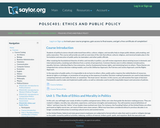
This course will provide the student with an overview of the role that ethical, cultural, religious, and moral principles play in public policy. The course will introduce the student to common themes found in the foundational theories of ethics and morality in politics such as justice, equality, fairness, individual liberty, free enterprise, charity, fundamental human rights, and minimizing harm to others. These themes are integrated into various decision-making models that you will learn about. Students will examine five types of decision frameworks used to make and implement public policy, as well as rationales used to justify inequitable impact and outcomes of policies. Upon successful completion of this course, students will be able to: explain how personal morality and ethics impact the policymaking process; discuss various ethical frameworks used to resolve policy dilemmas; identify statutes, ethical codes, and legal opinions that define the normative parameters of key domestic and international policy issues; assess the impact that public interest groups have on policymaking and execution of policies. (Political Science 401)
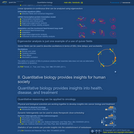
We express the exponential function of an imaginary variable in terms of sine and cosine. The "complex exponentials" that result trace out a circle in the complex plane. Pointing to one of the positions in the complex plane, we obtain the identity exp(i pi) = -1.
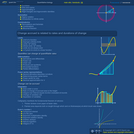
In the first video segment, we introduce Euler's number by considering the problem of interest compounded continuously. After we obtain the power-series representation for exp(x), we explore its properties, in the next four video segments, to convince ourselves that exp(x) is literally an exponential function, meaning a number, approximately 2.71828, taken to the power x. In the final two segments, we present the natural logarithm and demonstrate that it is the anti-derivative of 1/x.
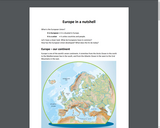
The Center for European Studies at UNC-CH is proud to present the Teaching the EU Toolkits. CES has a 20-year history of providing outreach materials and professional development on contemporary Europe. During this time, we have discovered that although there is much interest in teaching Europe, most resources are historic in nature, and do not allow students to fully grasp the rich cultures, languages, people, and politics of today’s Europe, Europeans, and the European Union. This project was generously funded by a Getting to Know Europe grant from the Delegation of the European Union to the US in Washington, DC.
This information sheet addresses the following information:
What is the European Union?
What do Europeans have in common?
How has the European Union developed? What does the EU do today?
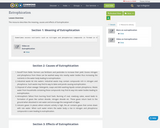
The resource describes the meaning, causes and effects of Eutrophication
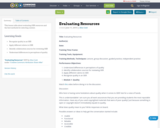
This lesson talks about evaluating OER resources and the best methods for selecting content.

Explore the concept of evaporative cooling through a hands-on experiment. Use a wet cloth and fan to model an air-conditioner and use temperature and relative humidity sensors to collect data. Then digitally plot the data using graphs in the activity. In an optional extension, make your own modifications to improve the cooler's efficiency.

There are materials that we are asking the participants to copy and bring with them to the class. There are materials that the Resource Center will provide for participants and there are materials that we are providing to participants that we ask for them to review prior to the class that do not need to be printed.
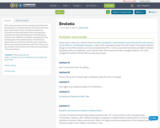
This course provides a broad conceptual and historical introduction to scientific theories of evolution and their place in the wider culture. It embraces historical, scientific and anthropological/cultural perspectives grounded in relevant developments in the biological sciences since 1800 that are largely responsible for the development of the modern theory of evolution by natural selection. Students read key texts, analyze key debates (e.g. Darwinian debates in the 19th century, and the creation controversies in the 20th century) and give class presentations.
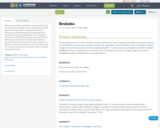
This course provides a broad conceptual and historical introduction to scientific theories of evolution and their place in the wider culture. It embraces historical, scientific and anthropological/cultural perspectives grounded in relevant developments in the biological sciences since 1800 that are largely responsible for the development of the modern theory of evolution by natural selection. Students read key texts, analyze key debates (e.g. Darwinian debates in the 19th century, and the creation controversies in the 20th century) and give class presentations.
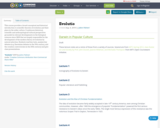
This course provides a broad conceptual and historical introduction to scientific theories of evolution and their place in the wider culture. It embraces historical, scientific and anthropological/cultural perspectives grounded in relevant developments in the biological sciences since 1800 that are largely responsible for the development of the modern theory of evolution by natural selection. Students read key texts, analyze key debates (e.g. Darwinian debates in the 19th century, and the creation controversies in the 20th century) and give class presentations.
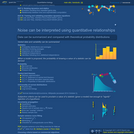
In the first video segment, we analyze the population dynamics for a test-tube of cells that affect each others' likelihoods of replication when they collide. The particular example we use is a prisoner's dilemma, which has the almost paradoxical property that survival of the relatively most fit leads overall fitness to decrease. In the second video segment, we suggest that the population dynamics from the first segment can be related to an analysis that uses payoff matrices found in traditional game theory.

Ontwerpen is een combinatie van logisch redeneren en het creatief combineren van bestaande technieken om tot nieuwe, innovatieve ideeen te komen. Een goede werktuigkundig ontwerper put zijn creativiteit uit kennis van een groot aantal bestaande werktuigbouwkundige systemen. Hoe groter die kennis, hoe groter de kans dat nieuwe, innovatieve ontwerpconcepten ontstaan. Vooral kennis over niet-conventionele techniek bevordert dit creatieve ontwerpproces.
Het doel van het vak Evolving Design is om studenten de onderhavige werkprincipes te tonen van een grote hoeveelheid niet-conventionele werktuigbouwkundige systemen. Er wordt hierbij zowel gekeken naar bijzondere ontdekkingen uit het verleden als uit het heden, met een blik op de toekomst. De ontwerpprincipes worden niet simpelweg opgesomd, maar geplaatst in hun fascinerende, historische ontwikkeling om te laten zien hoe de ontwerpers hun creativiteit en vernuft gebruik(t)en om goedwerkende oplossingen te vinden binnen de beperkingen van de beschikbare fabricageprocessen en beschermingsmogelijkheden (patenten). Veel oplossingen uit het verleden zijn klaar om te worden toegepast in de technologie van de toekomst!
Het vak richt zich primair op het kwalitatief beschrijven van de werkprincipes van bestaande technologieen, met de nadruk op bewegende mechanische constructies. Hoewel het kwantatief, in detail uitwerken van de kracht-bewegingsvergelijkingen niet het hoofddoel van het vak is, zijn mechanische vergelijkingen wel essentieel als zij leiden tot een beter begrip.
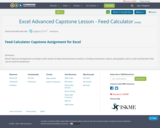
Excel Capstone Assignment covering a wide variety of topics from formula creation, to lookup statements, charts, and graphics, all in a real-world project that can be used in businesses.

Executive leadership exposes the leaner to leadership at the top of the organisation.

This OER explores the operation of a Telescope. It combines a lesson on lenses with a lesson using a Galileoscope. It also includes resources for further exploration. It is a product of the OU Academy of the Lynx, developed in conjunction with the Galileo's World Exhibition at the University of Oklahoma.

The content presented here provides module information, teaching materials and assessment details for module B74GS3 ‘Experiences of Health and Illness: Professional Perspectives’. This module is offered as part of the Post Graduate Diploma in Nursing Studies, Division of Nursing, University of Nottingham.
The content presented throughout includes module descriptions, lecture notes, workshop notes, case studies, clinical skills and reading lists provided to postgraduate students at the University of Nottingham.

This is a collection of mathematics problems relating to the moons of the solar system. Learners will use simple proportional relationships and work with fractions to study the relative sizes of the larger moons in our solar system, and explore how temperatures change from place to place using the Celsius and Kelvin scales.